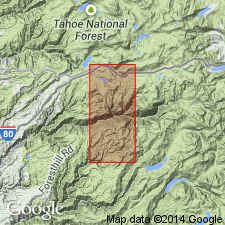
- Usage in publication:
-
- Big Valley Bluff Formation*
- Modifications:
-
- Named
- Biostratigraphic dating
- Dominant lithology:
-
- Quartzite
- Conglomerate
- AAPG geologic province:
-
- Sierra Nevada province
Summary:
Big Valley Bluff Formation is named for exposures at Big Valley Bluff (sec.25, T16N R12E, Duncan Peak 7.5' quad) and on the north rim of the North Fork of the American River east and west of Big Valley Bluff, Placer Co, CA. Reference section is exposed along the Foresthill Divide Road between Tadpole Campground and Ford Point (sec.5 and 6, T15N R13E). Consists of gray quartzite, and green, gray, and black pelite in graded turbidite beds that range in thickness from 10 cm to 2 m. Lenses of gray ribbon chert and a block of white and tan marble are also present. Maximum thickness is unknown, but is at least 7000 m. Overlies both the Antoine Canyon Formation (new) and the Screwauger Breccia (new); underlies Barney Cavanah Ridge Formation (new) and the chert unit of the Duncan Peak allocthon. Age is Ordovician(?) to Devonian(?) based on conodonts from a lens of limestone interbedded with turbidite-derived rocks north of map area, and the unit's position unconformably below Upper Devonian rocks.
Source: GNU records (USGS DDS-6; Menlo GNULEX).
For more information, please contact Nancy Stamm, Geologic Names Committee Secretary.
Asterisk (*) indicates published by U.S. Geological Survey authors.
"No current usage" (†) implies that a name has been abandoned or has fallen into disuse. Former usage and, if known, replacement name given in parentheses ( ).
Slash (/) indicates name conflicts with nomenclatural guidelines (CSN, 1933; ACSN, 1961, 1970; NACSN, 1983, 2005, 2021). May be explained within brackets ([ ]).

